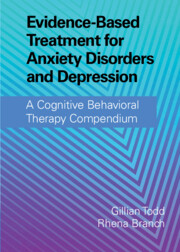 Evidence-Based Treatment for Anxiety Disorders and Depression
Evidence-Based Treatment for Anxiety Disorders and Depression An Updated Cognitive Behavioral Approach
from Part Three - Cognitive Behavioral Therapy for Obsessive-Compulsive Disorder and Associated Disorders
Published online by Cambridge University Press: 06 January 2022
Cognitive behavioral therapy (CBT) and exposure and response prevention (E/RP) remain the treatments of choice for OCD, but for many clients outcomes are suboptimal. In the first part of this chapter, we present the CBT approach to OCD, alongside four promising areas to inform and refine current interventions, namely, optimizing E/RP with inhibitory learning principles; understanding complexity in OCD, differences in disgust, and harm avoidance; and using imagery rescripting for clients with intrusive images. In the second part, we provide an updated CBT and E/RP approach to OCD that integrates these areas into the standard assessment and treatment protocol. The approach emphasizes the importance of a clear developmental formulation with links of past relevant experiences to current OCD, and understanding the context, function, and unintended consequences of obsessions and compulsions. OCD measures and screening tools are introduced.
To save this book to your Kindle, first ensure [email protected] is added to your Approved Personal Document E-mail List under your Personal Document Settings on the Manage Your Content and Devices page of your Amazon account. Then enter the ‘name’ part of your Kindle email address below. Find out more about saving to your Kindle.
Note you can select to save to either the @free.kindle.com or @kindle.com variations. ‘@free.kindle.com’ emails are free but can only be saved to your device when it is connected to wi-fi. ‘@kindle.com’ emails can be delivered even when you are not connected to wi-fi, but note that service fees apply.
Find out more about the Kindle Personal Document Service.
To save content items to your account, please confirm that you agree to abide by our usage policies. If this is the first time you use this feature, you will be asked to authorise Cambridge Core to connect with your account. Find out more about saving content to Dropbox.
To save content items to your account, please confirm that you agree to abide by our usage policies. If this is the first time you use this feature, you will be asked to authorise Cambridge Core to connect with your account. Find out more about saving content to Google Drive.